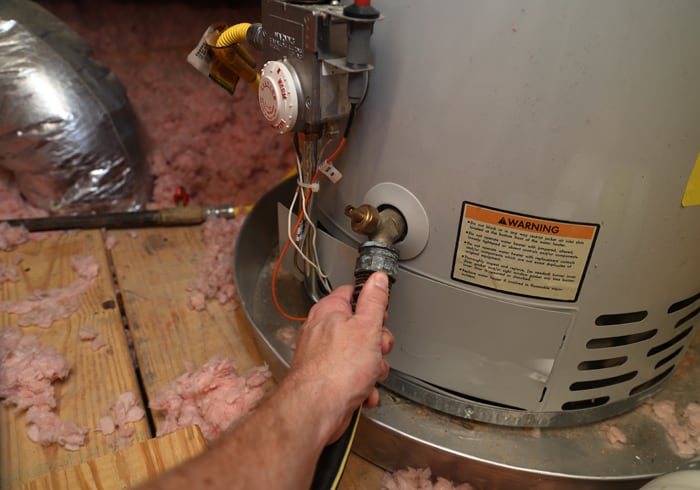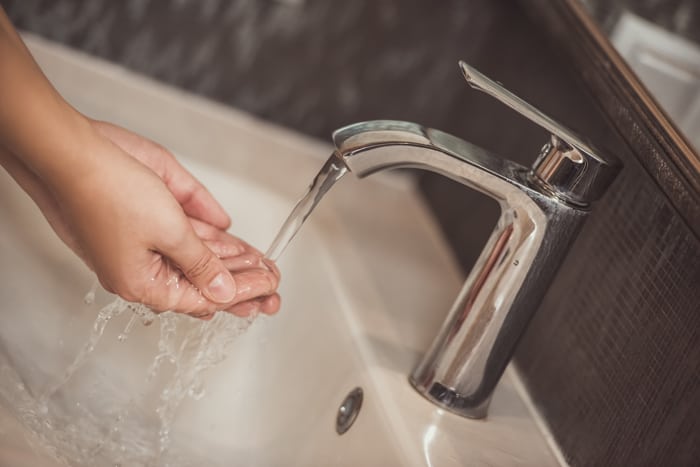The Benefits of Hot Water Heater Flushes – How and Why You May Need One
 How water heaters play a crucial role in our daily lives, providing warm water for showers, cleaning, and household activities. Over time, however, sediment buildup and mineral deposits can accumulate within the heater tank, affecting its efficiency and leading to issues like higher energy bills, a water heater leak or burst, and water damage.
How water heaters play a crucial role in our daily lives, providing warm water for showers, cleaning, and household activities. Over time, however, sediment buildup and mineral deposits can accumulate within the heater tank, affecting its efficiency and leading to issues like higher energy bills, a water heater leak or burst, and water damage.
Hot water heater flushes are a recommended maintenance task for your system. Here are the reasons why you should consider hot water heater flushes and the benefits they offer, straight from the pros at Bell Brothers.
What Are Hot Water Heater Flushes?
A hot water heater flush is exactly what it sounds like. During a water heater flush, the tank is completely emptied through a hose into an approved drain source. The tank is flushed of any sediment or mineral buildup that may reduce the heating efficiency of your water heater or lead to extensive plumbing damage.

Ideally, your water heater should be flushed at least once a year, but you may need to flush your water heater more often if you have a lot of sediment buildup. While you can flush your water heater yourself, using a professional plumber comes with advantages, such as having a plumber check over your water heater and ensure it’s operating as it should.
Why Are Hot Water Heater Flushes Important?
Here are some reasons you need hot water heater flushes:
Accumulation of Sediment and Materials
One of the main reasons for a hot water heater flush is that water heaters gradually accumulate sediment and minerals within the tank. As water flows into the heater, it carries along harsh minerals like calcium and magnesium.
Over time, these minerals settle at the bottom of the tank, forming a thick layer of sediment. This sediment can hinder the heating element’s efficiency and lead to various issues, including decreased water heater lifespan and increased energy consumption. Flushing your water heater removes this sediment and helps extend your appliance’s efficiency and lifespan.
Reduced Efficiency
Sediment buildup within a tank acts as an insulating barrier between the heating element and the water. As a result, the heating element has to work harder to raise the water temperature, leading to reduced energy efficiency.
This decreased efficiency not only contributes to higher energy bills but also puts additional stress on the heating system, potentially leading to premature wear and tear. When you flush your hot water heater regularly, you can improve its efficiency and ensure that it’s all operating as it should.
Corrosion Prevention
Another critical aspect of hot water heater flushes is the prevention of corrosion. Sediment accumulates at the bottom of the tank can create an environmental where bacteria thrive. These bacteria produce corrosive byproducts that can eat away at the tank’s interior, causing leaks and structural damage.
Regular flushing helps remove the sediment, minimizing the risk of corrosion and extending the overall lifespan of the water heater. A hot water heater is an investment, so you want to do all you can to get the most out of it.
Conducting a Hot Water Heater Flush
Hot water heater flushes are simple and straightforward, but if you’re not comfortable performing this task on your own, be sure to consult a professional plumber for plumbing maintenance.

- Turn Off the Power:Before beginning the flushing process, it is crucial to turn off the power supply to the water heater. For electric heaters, this means shutting off the circuit breaker, while gas heaters should be turned off using the dedicated gas valve.
- Turn Off the Water Supply:Next, turn off the water supply to the heater. This can usually be done by closing the inlet valve located near the top of the tank.
- Connect a Hose:Attach a garden hose to the drain valve located at the bottom of the water heater. Ensure the other end of the hose is directed towards a drain or outside, as the flushed water may contain sediment and debris.
- Open the Drain Valve:Open the drain valve to allow the water to flow out of the tank. This process can take some time, as sediment may cause slow drainage. Be patient and allow the tank to drain completely.
- Flush with Cold Water:Once the tank is drained, flush it with cold water to remove any remaining sediment. This can be done by turning on the water supply and allowing it to run through the tank and out of the drain valve for a few minutes.
- Close the Drain Valve:After flushing, close the drain valve, and disconnect the hose. Ensure that there is no leakage from the valve.
- Turn On the Water Supply and Power:Turn on the water supply to the heater and allow it to fill. Once the tank is filled, turn the power supply back on. For gas heaters, relight the pilot light following the manufacturer’s instructions.
The Benefits of Hot Water Heater Flushes
Improved Energy Efficiency

Extended Lifespan
The accumulation of sediment and mineral deposits within the tank can lead to the deterioration of the heating element and other components. Regular flushing helps prevent premature wear and tear, thereby extending the overall lifespan of the water heater. This not only saves you a lot of money on replacement costs but also reduces the environmental impact associated with manufacturing and disposing of appliances.
Consistent Water Temperature

Reduced Maintenance Costs
Regular maintenance, including hot water heater flushes, can significantly reduce the need for repairs and associated costs. Sediment-related issues, such as clogs and corrosion, are common reasons for heater malfunctions. By addressing these issues proactively, you can avoid expensive water heater repairs and emergency service calls.
Improved Water Quality

Sediment in the water heater not only affects the appliance but can also impact the quality of the water itself. As sediment accumulates, it may break loose and enter the household water supply, leading to discolored water and potential health concerns. Flushing the water heater helps maintain water quality, ensuring the water remains clear and free from contaminants.
Prevention of Tank Corrosion
Corrosion is a significant threat to the longevity of water heaters. The combination of sediment and bacteria within the tank can create an environment conducive to corrosion. Flushing the tank removes these corrosive elements, reducing the risk of leaks and structural damage. This preventative measure can save you from the inconvenience and expense of dealing with a leaking water heater.
Enhanced Water Heater Performance
Over time, sediment buildup can hinder the overall performance of the water heater. By conducting regular flushes, you can ensure that your water heater operates at peak efficiency. This means faster heating times, quicker recovery after periods of high demand, and overall improved performance.
How Often Should I Perform Hot Water Heater Flushes?
Determining how often to flush a hot water heater depends on various factors, including water hardness, usage patterns, and the manufacturer’s recommendations. As a general guideline, conducting a flush once a year is a good starting point for many households. However, in areas with particularly hard water, more frequent flushes may be necessary to prevent excessive sediment buildup.
It’s essential to consult the water heater manufacturer guidelines and take into account the specific conditions in your region. Additionally, if you notice signs of sediment accumulation of a decrease in water heater performance, it may be wise to schedule a flush sooner than the recommended annual interval.
Take Control of Your Plumbing Maintenance
Hot water heater flushes are a vital aspect of regular maintenance that can significantly impact the performance, efficiency, and lifespan of the appliance. By understanding the reasons behind the need for flushing and following the proper procedure, you can enjoy a reliable supply of hot water, lower energy bills, and an extended lifespan for their water heaters.
Do you need a hot water heater flush or other plumbing service?
Contact the pros at Bell Brothers and schedule your appointment!

